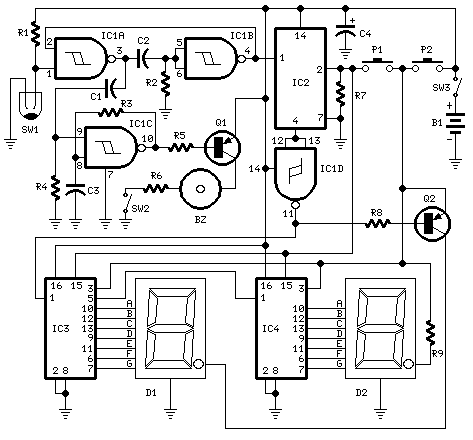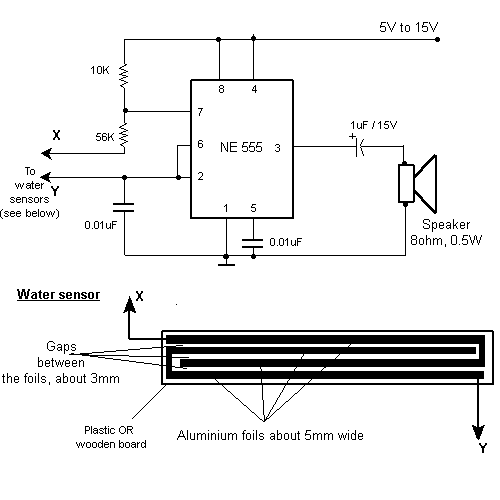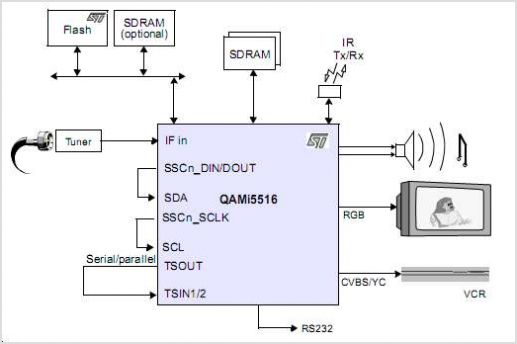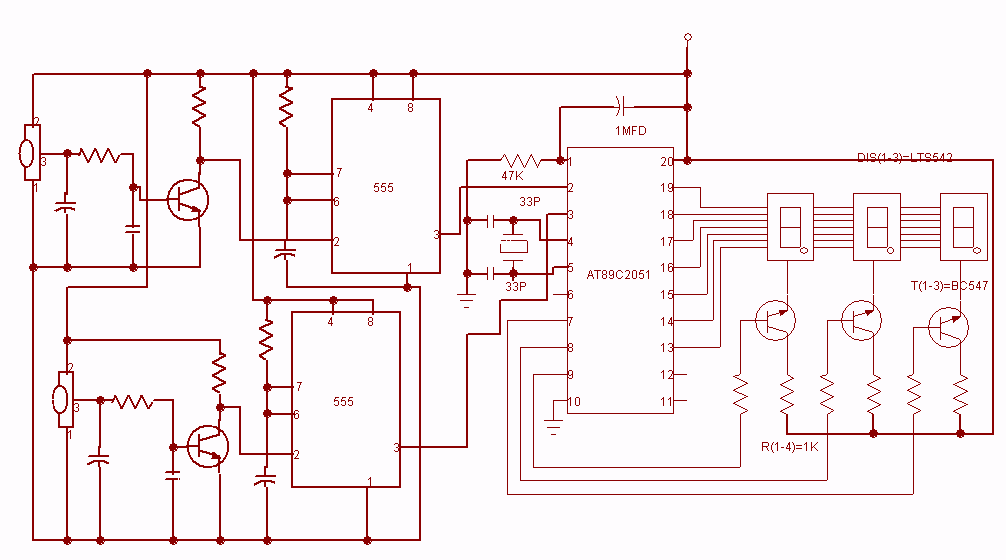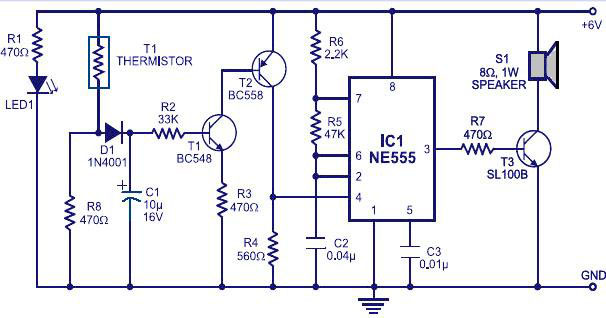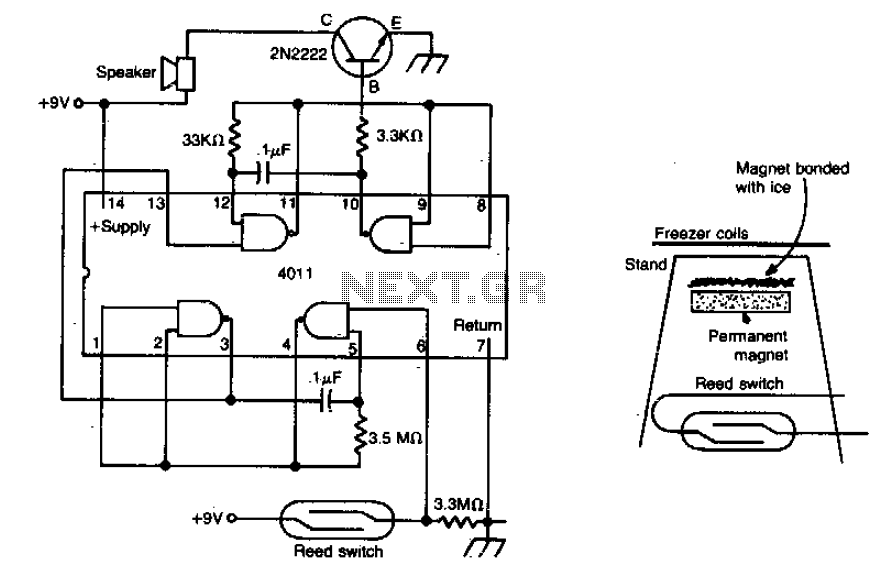
Enhanced 5 Digit Alarm Keypad
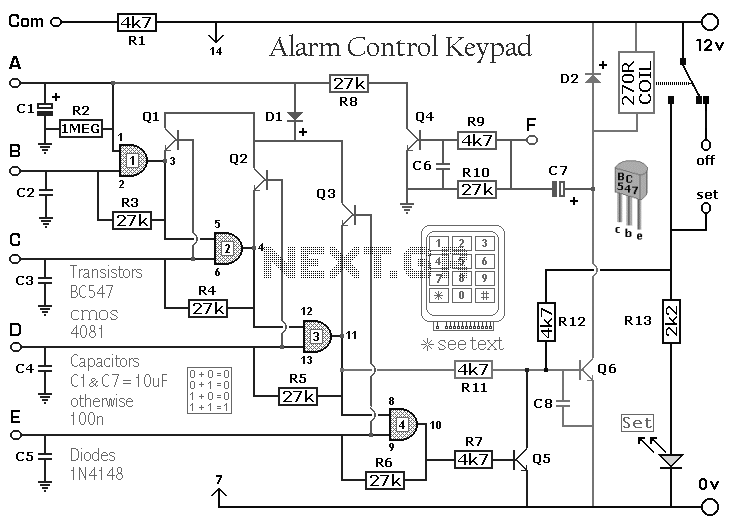
This switch is designed for the Modular Burglar Alarm circuit but can be utilized in various other applications. The keypad must feature a common terminal with separate connections for each key. For a 12-key pad, there should be 13 terminals available. The matrix type with 7 terminals is not suitable. Select five keys as the code and connect them to A, B, C, D, and E. The common terminal should be wired to R1, while all remaining keys connect to F. Given that the selection can include non-numeric symbols, there are nearly 100,000 different codes available. The alarm is activated by pressing the first four of the five chosen keys in the correct order within a time frame set by C1 and R2 (approximately 10 seconds). When A, B, C, and D are pressed in the correct sequence, current flows through R11, switching Q6 on. This action energizes the relay, which then maintains its state by supplying base current to Q6 through R12. The 12-volt output transitions from the "off" to the "set" terminal, illuminating the LED. To deactivate the alarm, it is necessary to press A, B, C, D, and E in the correct order. The integrated circuit used is a quad 2-input AND gate, specifically a CMOS 4081. These gates produce a high output only when both inputs are high. Pressing A raises pin 1 high for a duration determined by C1 and R2, enabling gate 1. Consequently, when B is pressed, the output at pin 3 goes high, performing two functions: it locks itself high via R3 and enables gate 2 by raising pin 5 high. The remaining gates function similarly, each locking itself on through a resistor and enabling the next gate in sequence. If the correct code is entered within the allowed time, pin 10 activates Q5, which connects the base of Q6 to ground, thus turning Q6 off and causing the relay to disengage. Any keys not connected to A, B, C, D, or E link to the base of Q4 through R9. When a "wrong" key is pressed, Q4 pulls pin 1 low, removing the enable from gate 1 and causing the code entry process to fail. If C, D, or E is pressed out of order, Q1, Q2, or Q3 will also pull pin 1 low, resulting in the same failure. The code can be modified by changing the keypad connections. Mistakes during code entry necessitate restarting the process. For enhanced security, a larger keypad with more "wrong" keys connected to F can be used; a 16-key pad offers over half a million different codes. All components are depicted lying flat on the board, though some are mounted upright. The links are bare copper wires on the component side, with two links needing to be fitted before the IC. The support material for this circuit includes a step-by-step construction guide for the circuit board, a parts list, a detailed circuit description, and additional resources.
The Modular Burglar Alarm circuit employs a sophisticated method of user authentication through a keypad interface, integrating a series of components that work together seamlessly to provide a reliable security solution. At the core of the system is the CMOS 4081 quad 2-input AND gate, which is pivotal in determining the validity of the entered code. The design allows for flexibility in code selection, accommodating both numeric and non-numeric symbols, thereby enhancing the complexity of potential codes.
The current flow through resistors R11 and R12 is crucial for activating the relay and illuminating the LED indicator, signaling the alarm's status. The timing elements, C1 and R2, are carefully selected to ensure that the user has a reasonable window to input their code, adding to the user-friendly nature of the system.
The circuit's response to incorrect key presses is designed to prevent unauthorized access effectively. By utilizing additional gates and resistors, the system can quickly invalidate an entry if any incorrect key is pressed, thereby protecting the alarm from being inadvertently triggered.
Moreover, the option to modify the keypad connections allows the user to personalize their security code, further enhancing the system's adaptability. The use of a larger keypad not only increases the number of possible codes but also provides an additional layer of security, making it significantly more challenging for unauthorized users to guess the correct sequence.
Lastly, the construction of the circuit board is meticulously detailed in the provided support material, ensuring that users can replicate the setup accurately and efficiently. This thorough documentation, combined with the robust design of the Modular Burglar Alarm circuit, exemplifies a well-thought-out approach to electronic security solutions.This switch will suit the Modular Burglar Alarm circuit. However, it also has other applications. The Keypad must be the kind with a common terminal and a separate connection for each key. On a 12-key pad, look for 13 terminals. The matrix type with 7 terminals will NOT do. Choose the five keys you want as your code, and connect them to `A, B, C, D & E`. Wire the common to R1 and all the remaining keys to `F`. Because your choice can include the non-numeric symbols, almost 100 000 different codes are available. The Alarm is set using the first four of your five chosen keys. When `A, B, C & D` are pressed in the right order and within the time set by C1 and R2 (about 10 seconds), current through R11 switches Q6 on.
The relay energizes, and then holds itself on by providing base current for Q6 through R12. The 12-volt output switches from the "off " to the "set " terminal, and the LED lights. To switch the Alarm off again it is necessary to press A, B, C, D & E in the right order. The IC is a quad 2-input AND gate, a Cmos 4081. These gates only produce a high output when both inputs are high. Pressing `A` takes pin 1 high for a period of time set by C1 and R2. This `enables` gate 1, so that when `B` is pressed, the output at pin 3 will go high. This output does two jobs. It locks itself high using R3 and it enables gate 2 by taking pin 5 high. The remaining gates operate in the same way, each locking itself on through a resistor and enabling its successor. If the correct code is entered within the time allowed, pin 10 will switch Q5 on and so connect the base of Q6 to ground.
This causes Q6 to switch off and the relay to drop out. Any keys not wired to `A, B, C, D or E ` are connected to the base of Q4 by R9. Whenever one of these `wrong` keys is pressed, Q4 takes pin 1 low. This removes the `enable` from gate 1, and the code entry process fails. If C, D or E is pressed out of sequence, Q1, Q2 or Q3 will also take pin 1 low, with the same result. You can change the code by altering the keypad connections. If you make a mistake entering the code, just start again. If you need a more secure code you can use a bigger keypad with more `wrong` keys wired to `F`. A 16-key pad gives over half a million different codes. All components are shown lying flat on the board; but some are actually mounted upright. The links are bare copper wires on the component side. Two of the links must be fitted before the IC. The Support Material for this circuit includes a step-by-step guide to the construction of the circuit-board, a parts list, a detailed circuit description and more.
🔗 External reference
The Modular Burglar Alarm circuit employs a sophisticated method of user authentication through a keypad interface, integrating a series of components that work together seamlessly to provide a reliable security solution. At the core of the system is the CMOS 4081 quad 2-input AND gate, which is pivotal in determining the validity of the entered code. The design allows for flexibility in code selection, accommodating both numeric and non-numeric symbols, thereby enhancing the complexity of potential codes.
The current flow through resistors R11 and R12 is crucial for activating the relay and illuminating the LED indicator, signaling the alarm's status. The timing elements, C1 and R2, are carefully selected to ensure that the user has a reasonable window to input their code, adding to the user-friendly nature of the system.
The circuit's response to incorrect key presses is designed to prevent unauthorized access effectively. By utilizing additional gates and resistors, the system can quickly invalidate an entry if any incorrect key is pressed, thereby protecting the alarm from being inadvertently triggered.
Moreover, the option to modify the keypad connections allows the user to personalize their security code, further enhancing the system's adaptability. The use of a larger keypad not only increases the number of possible codes but also provides an additional layer of security, making it significantly more challenging for unauthorized users to guess the correct sequence.
Lastly, the construction of the circuit board is meticulously detailed in the provided support material, ensuring that users can replicate the setup accurately and efficiently. This thorough documentation, combined with the robust design of the Modular Burglar Alarm circuit, exemplifies a well-thought-out approach to electronic security solutions.This switch will suit the Modular Burglar Alarm circuit. However, it also has other applications. The Keypad must be the kind with a common terminal and a separate connection for each key. On a 12-key pad, look for 13 terminals. The matrix type with 7 terminals will NOT do. Choose the five keys you want as your code, and connect them to `A, B, C, D & E`. Wire the common to R1 and all the remaining keys to `F`. Because your choice can include the non-numeric symbols, almost 100 000 different codes are available. The Alarm is set using the first four of your five chosen keys. When `A, B, C & D` are pressed in the right order and within the time set by C1 and R2 (about 10 seconds), current through R11 switches Q6 on.
The relay energizes, and then holds itself on by providing base current for Q6 through R12. The 12-volt output switches from the "off " to the "set " terminal, and the LED lights. To switch the Alarm off again it is necessary to press A, B, C, D & E in the right order. The IC is a quad 2-input AND gate, a Cmos 4081. These gates only produce a high output when both inputs are high. Pressing `A` takes pin 1 high for a period of time set by C1 and R2. This `enables` gate 1, so that when `B` is pressed, the output at pin 3 will go high. This output does two jobs. It locks itself high using R3 and it enables gate 2 by taking pin 5 high. The remaining gates operate in the same way, each locking itself on through a resistor and enabling its successor. If the correct code is entered within the time allowed, pin 10 will switch Q5 on and so connect the base of Q6 to ground.
This causes Q6 to switch off and the relay to drop out. Any keys not wired to `A, B, C, D or E ` are connected to the base of Q4 by R9. Whenever one of these `wrong` keys is pressed, Q4 takes pin 1 low. This removes the `enable` from gate 1, and the code entry process fails. If C, D or E is pressed out of sequence, Q1, Q2 or Q3 will also take pin 1 low, with the same result. You can change the code by altering the keypad connections. If you make a mistake entering the code, just start again. If you need a more secure code you can use a bigger keypad with more `wrong` keys wired to `F`. A 16-key pad gives over half a million different codes. All components are shown lying flat on the board; but some are actually mounted upright. The links are bare copper wires on the component side. Two of the links must be fitted before the IC. The Support Material for this circuit includes a step-by-step guide to the construction of the circuit-board, a parts list, a detailed circuit description and more.
🔗 External reference
